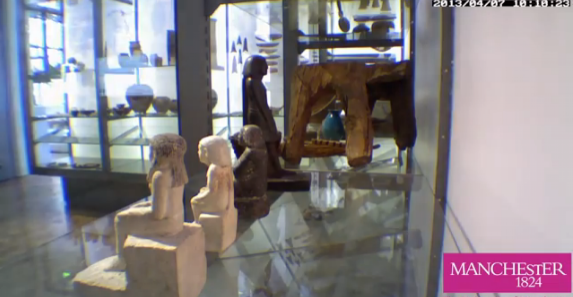Spinning Egyptian Statue: The Physics Behind Object Walking In Museums

It seems truly ominous: Seemingly by its own power, an Egyptian relic rotates on a shelf.
This time-lapse video shows a nearly 4,000-year-old, 10-inch-high statue of a man named Neb-Sanu slowly turning around inside its display case at England’s Manchester Museum:
But before you start entertaining thoughts of a mummy’s curse, consider the alternatives. In this day and age, when some inexplicable phenomenon crops up on a viral video, it’s hard not to immediately presume the invisible hand of some marketer or advertiser could be involved. However, assuming that the rotating statue isn’t a viral ad, there is a perfectly natural explanation for the object’s movement: vibration.
When you look at the rotating statue, you may notice that the statue moves only as people are walking by. Vibration, which can be caused merely by the foot traffic of passersby, is a well-known problem in museums, especially on wooden floors -- the kind that are in the room that houses the Egyptian statue. Objects on glass shelves, like the Neb-Sanu statue, have been known to “walk” short distances.
David Thickett, a conservationist at the British Museum, investigated vibration damages to museum objects in a paper presented at a 2002 meeting of the International Committee for Conservation in Rio de Janeiro. He noted that in various galleries of the British Museum instruments recorded background vibration levels of anywhere between .006 and .15 g-force.
“In order for an object to walk, the vibration must overcome the friction between the object base and the shelf,” Thickett wrote. “The friction forces depend on three factors: the weight of the object, the contact area between the object or its support and the shelf, and the shelf and object or object support materials.”
In the British Museum, ambient vibrations loosened tiles from Aztec artifacts and worked the tails of two African ivory leopard sculptures from the holes in a wall that kept them affixed. Thickett also found instances of object-walking on glass shelves, with vibration levels as low as .02 g-force. A 1-pound bronze statue walked along a Lucite base while a neighboring sculpture weighing .7 pounds stayed put on a glass shelf.
One remedy for object walking is to put a bit of wax on the base of an object. But conservators have to consider whether the wax might damage a fragile artifact.
At Metabunk.org, a user named Mick set up his own experiment to show that an object can be moved around by vibration. With a glass tabletop standing in for the museum’s glass shelf and a container of garlic salt sitting atop a wood plank standing in for the statue, vibrations of the table are enough to create rotation:
But why is the statue moving now? Wouldn’t someone have noticed the movement before? The Neb-Sanu figure is actually resting in a relatively new home -- the Ancient Worlds gallery only opened this past October.
Plus, Mick wrote, his “experiments show the motion is dependent on circumstances. So something must have changed, but only very slightly -- the slope of the shelf, the position of the statue on the shelf, even the position of other objects can affect the vibration. Even a very slight shift in the frame of the building could be responsible.”
The other statues on the shelf don’t move because of their individual features -- they’re shorter, giving them a lower center of gravity, and are made of different materials. Metabunk’s Mick also stated that the statue is pivoting on a point in its base and spinning exactly 180 degrees because the shelf slopes down toward the front of the display, so once the statue gets to the point where its center of gravity is lowest it stops.
© Copyright IBTimes 2025. All rights reserved.





















